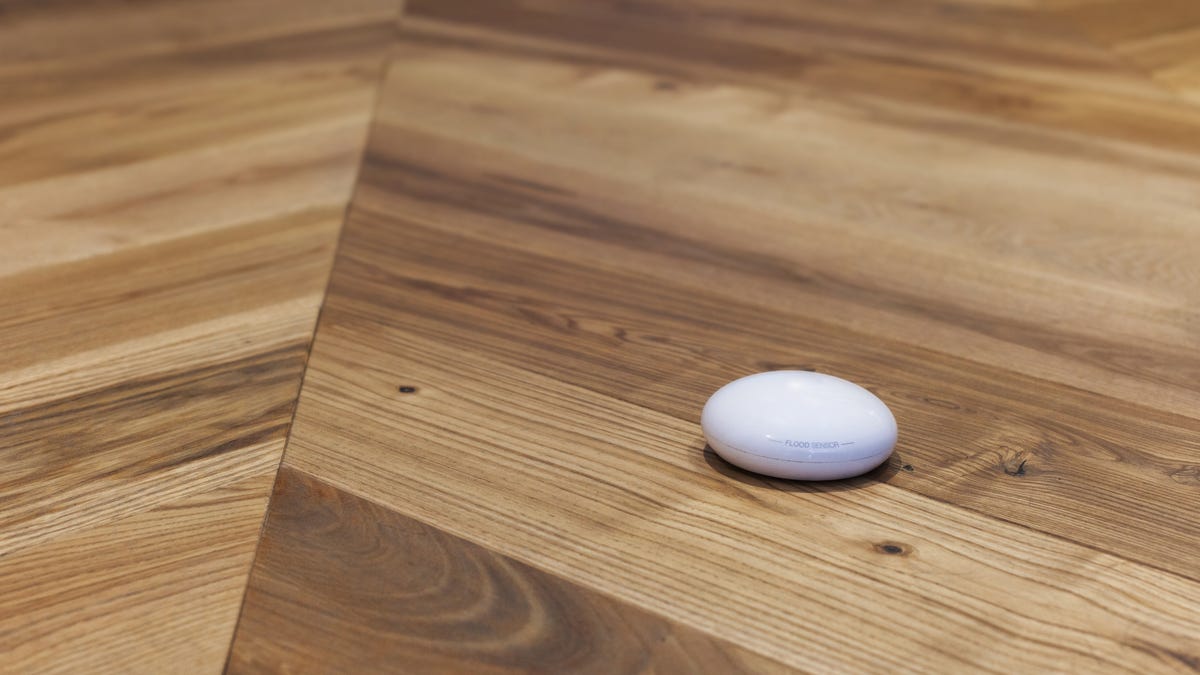 Why You Can Trust CNET
Why You Can Trust CNET How to install a water leak sensor in no time
A leak sensor is a quick and affordable way to identify potentially damaging water leaks.

Single-room leak sensors are pretty nondescript, but these budget-friendly devices can quickly alert you to water in your home.
If you're a homeowner, you've almost certainly dealt with your fair share of maintenance issues and emergencies. However, there are few things as alarming as plumbing problems, such as leaks, floods and water damage.
Smart leak sensors -- also called water leak detectors -- are designed to prevent these types of incidents. These Wi-Fi-enabled sensors can monitor for leaks within your home, sending you a text message or push notification when a leak is detected. Many of these devices integrate with smart home systems, such as Google Home and Apple HomeKit, giving you even more insight and control over your property.
Whether you have water coming out of your refrigerator, toilet or dishwasher, leak sensors can help you pinpoint the problem, so you can fix it before it leads to flooding or other severe damage.
In this guide, we'll walk you through the process of installing a water leak sensor in your home. Keep in mind that these are general guidelines, so the specifics may vary depending on your particular product. We'll also give you more general information about leak detectors, including where to buy them, how much they cost and popular brands to consider.
Connect the leak sensor to your smartphone
Before your smart sensor can alert you to spills and leaks, it needs to be connected to your smartphone. First, head to the Google Play Store or Apple App Store and download the sensor manufacturer's mobile app. As an example, if you have a Samsung SmartThings Water Leak Sensor, you would download the SmartThings app.
After installing the app, follow the prompts to configure your new leak detector. If your sensor is battery powered, open it up and insert the batteries. If it has a power cord, make sure it's plugged in. The process will be slightly different for each brand, but it usually involves giving your sensor a name (e.g., Laundry Room Leak Sensor) and connecting it to your home Wi-Fi.
For individual leak sensors: Place them near potential leaks
After you've finished the technical setup, installing a battery-powered leak sensor is incredibly easy. For basic, all-in-one gadgets like the Phyn Smart Water Sensor Alarm, all you need to do is position it near the appliance or water pipes that you'd like to monitor for leaks.
Your device should have probes on the top and bottom, which can detect drips, puddles and changes in temperature or humidity. In some cases, you might connect an extension node to your leak detector (via a sensor cable) to fit into small or hard-to-reach places. Either way, you'll want to make sure that your sensor or extension node is in an area where it could detect leaks if they were to occur -- such as next to your washing machine or underneath your sink.
For plumbing-connected leak sensor systems: Hook them up to your pipes
As an alternative to these simple, battery-powered leak detectors, there are also more sophisticated leak sensor systems that connect to your valves and shut off your water supply when a leak is detected. If you have one of these devices, the setup process is slightly more complicated -- but still easy enough to complete on your own.
For example, let's say you're installing a device like the Phyn Smart Water Assistant underneath your kitchen sink. After configuring the app, you'll need to shut off the water under your sink and then run the tap to release the water in the lines.
From there, put a bucket beneath the water stop valve and disconnect the water hose before giving the valve a quick clean. Attach the leak sensor to your plumbing, with one side connected to the water stop valve and the other hooked up to the hose. When you're done, run the water from your sink to clear the lines and check for drips. Finally, mount the monitoring device on the inside of your cupboard, near the sensors.
Once you're completed these steps, you're done. When a leak occurs, your sensor should spring into action, sending you an alert and shutting down your water supply (if it's connected to your plumbing).
The bottom line
Investing in a leak sensor is a small but significant step you can take to protect your home and prevent expensive water damage. Not only are sensors easy to install, but they're also affordable, giving you an easy way to avoid serious issues like burst pipes and flooding. You can find cheap leak detectors online or at your local hardware store, with many models costing less than $50.